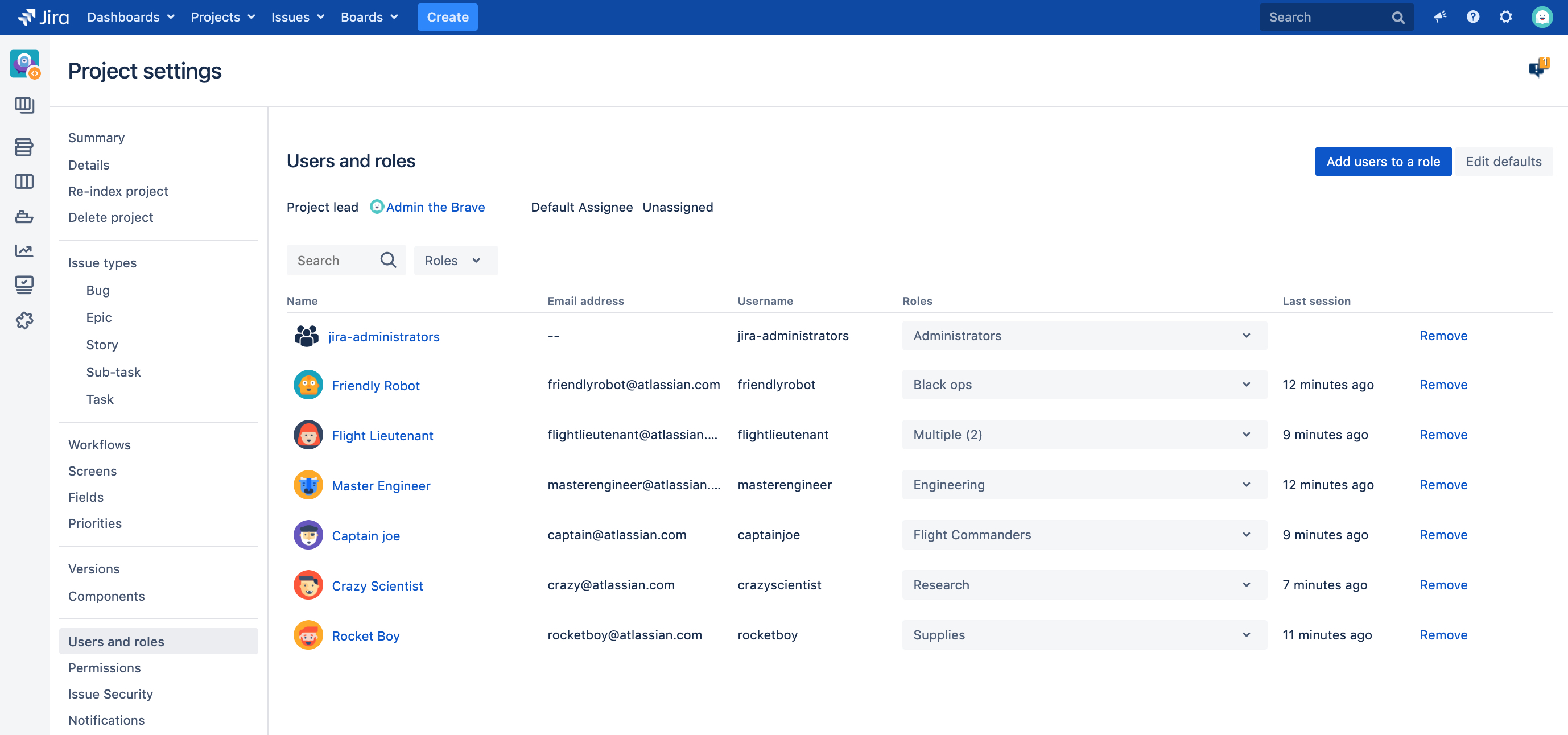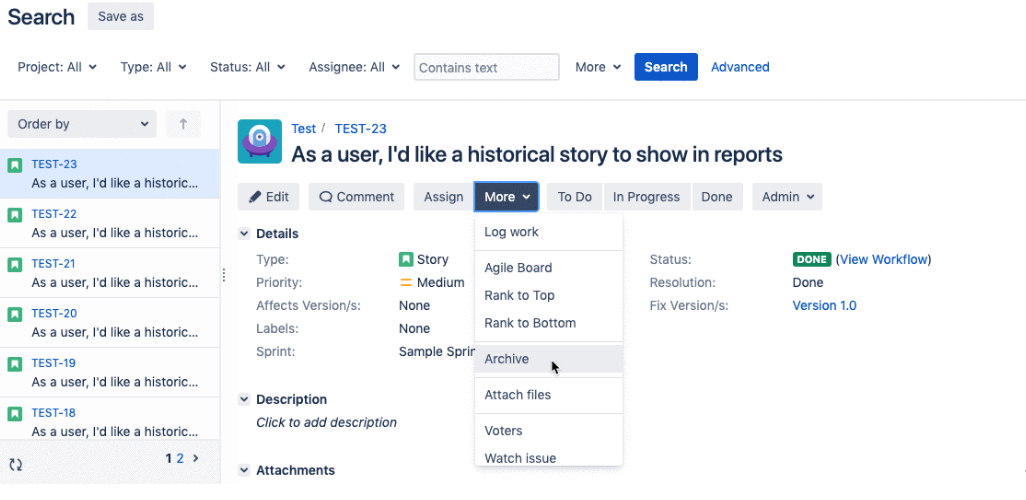Jira Software 8.6.x release notes
17 December 2019
We're pleased to present Jira Software 8.6.
Highlights
- Jira copies over changes files on upgrade
- New JVM code cache check
- Replying to JIRA notifications in Outlook made way better
- Users and roles made better
- PostgreSQL 10 comes to Jira
- Several older platforms get deprecated
- Prefix and suffix search
- Accessible dropdown menus
- Configurable scheme parameters in Jira REST API for projects creation
- Burnup charts in Jira Software
Interested in trying a shiny new version? Don't forget to renew your active software maintenance! Renew now.
If you're looking for compatible Jira applications, look no further:
If you're thinking to move to Data Center, check our recommendations first. See: Infrastructure recommendations for Jira.
Our Jira Pro Tip for this release
Do you know there is an easy way to archive 1k+ issues? That's super useful if your Data Center instance is large and your time to archive that heap of old issues is limited. Learn more...
Jira copies over changes files on upgrade
We are ironing out upgrade hurdles for you. Now, you do not need to copy over the files you changed to keep your customizations after your upgrade . Jira detect s the files you have altered in your old version and copies them to your new Jira instance. And in the meantime , you can just sit back and play around new features. See our upgrade guide for more info.
New JVM code cache check
This new check verifies that you’re using the recommended JVM configuration for code cache memory. Insufficient code cache memory can impact performance. This check is already available to customers who manually update the ATST app to 1.30.0. It will run automatically. Learn more
Replying to Jira notifications in Outlook is now way easier
In response to many requests, we have found a solution for customers who want to enable their users to reply to Jira notifications and leave comments in tickets using Outlook. In the wake of the changes, we have decided to deprecate two email handlers ( ”Add a comment from the non-quoted email body” and ”Create a new issue or add a comment to an existing issue”). For more information on how to set up replying to Jira notifications in Outlook, see Jira KB.
Update:
Since making this statement, we've received important feedback and decided to revert the deprecation. Learn more
Users and roles made better
We rolled up our sleeves and improved the Users and roles page within project settings. This should allow project admins to easily add people to a project and give them all the roles they need, in a blink of an eye.
Now, it’s more about assigning roles to a user than the other way round. You can also search for users, view and select roles from a drop-down menu, and have everybody shown on a single list, with nice columns explaining what’s what. You can check this out in Project settings > Users and roles.
PostgreSQL 10 comes to Jira
We’re welcoming a new database among our supported platforms — PostgreSQL 10. Learn more
…and some older platforms get deprecated
Adding new and shiny databases requires that we shift our efforts and stop supporting some of the old ones. Here’s a list of platforms that we’re deprecating:
SQL Server 2012
PostgreSQL 9.4
Solaris
Oracle 12c R1
PostgreSQL 9.5
MySQL 5.6
SQL Server 2014
We’ll stop supporting these in Jira 8.8 with the exception of MySQL 5.6 and SQL Server 2014 which will still be around until Jira 8.11. Learn more
Prefix and suffix search
Stuck when searching for an issue because you can't remember its exact name? As of Jira 8.0 we enabled prefix search:
text ~ "work*"and now we're adding suffix search to the bunch so that you can find exactly what you need in no time at all:
text ~ "*box"Accessible dropdown menus
To improve the user-friendliness of the More menu on the issue view and the context menu that displays in the backlog after you right-click, we added a scroll functionality that lets you see all the items on the list.
Configurable scheme parameters in Jira REST API for projects creation
Now you can fully automate creating new projects with specific workflowSchemes. We have extended Jira REST API and added a new endpoint and a new parameter:
POST
/rest/api/2/projectwith a new optionalworkflowSchemeIdfield to create a project and assign a worflowSchemeGET
/rest/api/2/project/{projectKeyOrId}/workflowschemeto get info about workflowScheme configured for a project
Burnup charts in Jira Software Server
Keep teams on track with a visual representation of a sprint's scope and identify problems such as scope creep or a deviation from the planned project path. So far available in Jira Cloud offering, now burnup charts are also available in Server.
You can find your team's burnup chart in the Reports section together with other reports.
More granular sprint permissions
On top of the existing Manage sprints permission that allows you to perform all sprint-related tasks, we are now adding the Start/Complete sprints permission that allows a user to start and stop a sprint if the dates or duration is set, and the Edit sprints permission that allows a user to edit the name and goal of the sprint. In this way, you can be more detailed and granular in configuring your permissions and assigning task to specific users.
Self-protect and sleep easy with rate limiting DATA CENTER
Without protections in place, automated integrations and scripts can hammer your Jira instance with huge bursts of requests, leading to drops in performance and downtime. This creates unnecessary work for admins who get paged (often after hours) to fix issues, and then have to comb through logs to find the culprit so it doesn’t happen again.
Rate limiting changes all this by giving your Jira instance the power to self-protect. Admins can now control how many REST API requests automations and scripts can make, and how often they can make them, meaning increased performance and team productivity (and hopefully for admins, more sleep too). Learn more
New information in the audit log DATA CENTER
As an admin, you have now more insights into what's going on on your instance. We've added several important pieces of information to help you get a full set of info you can track and manage.
These are the new available items:
- Dark feature enabled/disabled
- Jira service deleted
- Project role created
- JMX monitoring enabled/disabled
Cluster monitoring DATA CENTER
We've extended the capabilities of the Atlassian Cluster Monitoring plugin that was so far bundled with Confluence and Crowd to monitor Jira clusters as well.
This way you have now more tools to manage your data center nodes. We're displaying all your clustered nodes on a separate page with the information on node uptime (since last restart), ID, load and memory. The list will only show active nodes so a node which is down will not be displayed. The information available on the page can also help you decide if a node you've just added to the cluster has been configured correctly.
The page is available for Jira System admins.
To see the clustering information, go to Jira Administration > System > Clustering. To drill down and see runtime and system information, click More for a specific node.
Resolved issues
Issues resolved in 8.6.0
Released on 17 December 2019
Issues resolved in 8.6.1
Released on 9 January 2020









